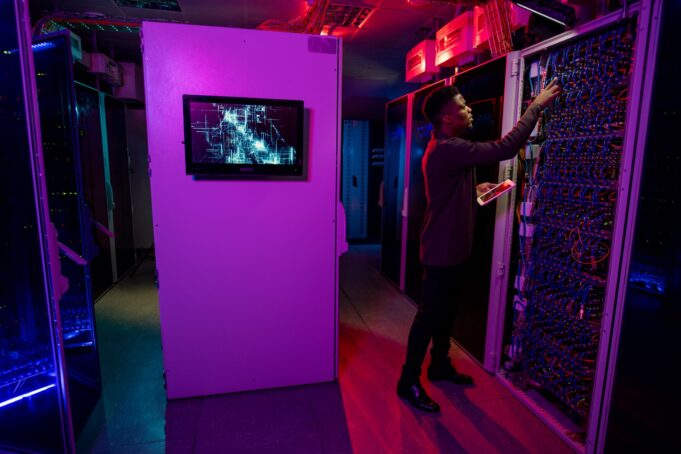One innovative technology is revolutionizing how facilities are managed: digital twins. These virtual models replicate physical assets, systems, or processes, provided real-time data and simulations. In hospitals, where efficiency and safety are essential, digital twins offer a powerful solution. They allow staff to predict maintenance needs, prevent breakdowns, and optimize daily operations. The result is a smoother, safer environment for both patients and healthcare providers.
What are Digital Twins?
A digital twin is a detailed digital replica of physical assets, systems, or spaces. It continuously collects data through sensors, IoT devices, and real-time feedback, which is then processed and analyzed using machine learning algorithms and artificial intelligence. This enables facility managers to create simulations and make informed decisions based on actual conditions, predicting future failures, improving performance, and optimizing the facility’s operations.
In the context of hospitals, digital twins can be created for a variety of assets, such as HVAC systems, patient rooms, or even the entire building infrastructure. By integrating Building Information Modeling (BIM) with real-time data, facility managers can monitor asset conditions, enhance energy management, and support overall hospital operations.
The Role of Digital Twins in Hospital Facility Management
Hospitals present unique challenges to facility managers due to their complexity and the critical nature of their operations. From ensuring optimal indoor air quality to maintaining equipment that supports life-saving procedures, the stakes are high. Here are several ways digital twins are transforming hospital facility management:
1. Enhanced Maintenance and Predictive Analytics
Hospitals operate around the clock, and failures in systems like HVAC or power supply can lead to dangerous outcomes. Digital twins provide predictive maintenance capabilities allowing facility managers to forecast when critical systems are likely to fail. Instead of reacting to breakdowns, predictive analytics allow facilities to replace components as repair systems before they fail. According to Intellias, digital twins can detect anomalies and alert facility managers in real-time, which reduces downtime and prevents expensive emergency repairs.
2. Optimizing Energy Usage
Hospitals are energy-intensive environments. Digital twins can help facility managers track and optimize energy usage, minimizing operational costs without compromising patient care. Through real-time monitoring of systems like lighting, HVAC, and medical equipment, digital twins enable hospitals to implement energy-saving strategies. A study published in the Journal of Facility Management Systems highlighted the role of digital twins in reducing energy consumption by offering insights into where the energy waste occurs and how to remediate it.
3. Improved Space Management and Design
Hospitals are dynamic environments, where space needs often fluctuate due to patient demand. A digital twin can simulate space utilization, helping facility managers allocate resources efficiently. For instance, when hospital admissions surge during a pandemic, digital twins can help optimize bed allocations or ensure compliance with social distancing requirements. As reported by FMS Systems, digital twins can even be used to design future expansions, helping decision-makers test different layouts and designs without disrupting ongoing operations.
4. Enhanced Safety and Compliance
Compliance with health and safety standards is non-negotiable in hospitals. Digital twins ensure that facility managers can continuously monitor for compliance issues, such as indoor air quality, proper equipment sterilization, and optimal conditions for medical procedures. A report published by ASCE Library explored how digital twins can help hospitals comply with stringent regulatory standards by offering real-time data that demonstrates adherence to guidelines.
5. Disaster Preparedness and Risk Management
Hospitals need to be ready for emergencies such as natural disasters or pandemics. Digital twins allow for simulation-based training, enabling hospital staff to plan for worst-case scenarios in a virtual setting. For example, during a fire drill or a pandemic outbreak, the digital twin of the hospital infrastructure can simulate patient movement patterns and evacuation procedures. As ResearchGate points out, these simulations provide critical insights into how to manage both human and facility resources during crises.
Challenges of Implementing Digital Twins in Hospitals
Despite the clear benefits, implementing digital twin technology in hospital settings comes with challenges:
- Data Privacy and Security: Hospitals handle sensitive patient data, and the integration of digital twins must comply with health privacy regulations like HIPAA. Real-time monitoring of hospital spaces requires secure networks and robust cybersecurity protocols to protect data.
- Integration with Existing Systems: Hospitals are often complex environments with multiple legacy systems. Integrating these systems into a unified digital twin can be difficult, requiring both financial investment and careful planning.
- Initial Costs: The upfront cost of implementing a digital twin can be high due to the need for sensors, IoT devices, and advanced software. However, the return on investment comes through long-term savings in operational costs and improved efficiency.
From predicting maintenance needs to optimizing energy use, digital twin technology helps hospitals run more efficiently. It also plays a key role in disaster preparedness, ensuring hospitals are ready for unexpected challenges. While the initial integration can be complex, the long-term benefits make it worth the effort. As more hospitals adopt digital twins, their ability to operate proactively and resiliently will continue to grow.
Sources
Digital Twin Application in Healthcare Facilities Management
Digital Twins: A Visionary Perspective
Digital Twin-Based Health Care Facilities Management
Digital Twins for Facility Management: Straightforward Path to Adoption
Digital twin for healthcare systems
The role of Digital Twins for Transformative Facilities Management






